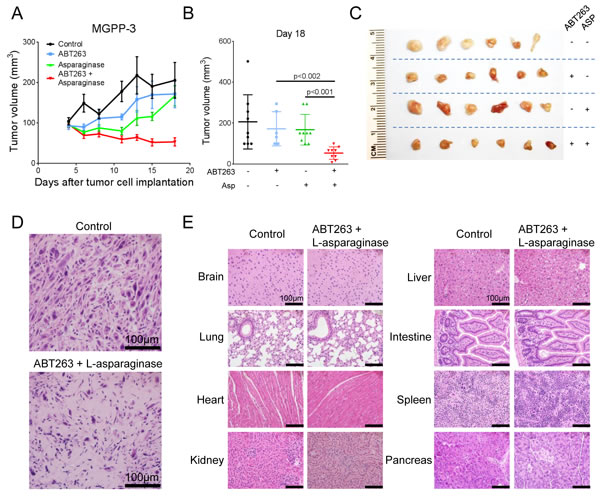Interview with Dr. Karpel-Massler & Dr. Siegelin from Columbia University Medical Center
Oncotarget published " Metabolic reprogramming of glioblastoma cells by L-asparaginase sensitizes for apoptosis in vitro and in vivo " which reported that the results suggest that certain glioma cell cultures are particularly susceptible to inhibition of proliferation by L-asparaginase, while others display a more resistant phenotype.
In sensitive cells, L-asparaginase induces apoptosis with dissipation of mitochondrial membrane potential and activation of effector caspases.
Given the impact of L-asparaginase on these molecules, the researchers found that L-asparaginase potently overcomes resistance to both intrinsic apoptosis induced by the Bcl-2/Bcl-xL inhibitor, ABT263, and extrinsic apoptosis mediated by TRAIL even in glioma cells that are resistant towards L-asparaginase single treatment.
In vivo, combined treatment with ABT263 and L-asparaginase led to an enhanced reduction of tumor growth when compared to each reagent alone without induction of toxicity.
The observations in the Oncotarget study suggest that L-asparaginase might be useful for the treatment of malignant glial neoplasms.
The Oncotarget study suggest that L-asparaginase might be useful for the treatment of malignant glial neoplasms
Dr. Markus D. Siegelin from The Columbia University Medical Center said, "Amino acid metabolism might represent an “Achilles heel ”in cancer since a number of tumors acquire an altered dependency on some of these metabolic pathways. "
Aside from glutamine, asparagine is pivotal for survival of a number of malignancies .
This is exemplified most prominently in the setting of acute lymphoblastic leukemia since in many of these malignant cell clones the levels of the enzyme asparagine synthetase, which utilizes aspartate and glutamine as a substrate to produce asparagine are suppressed.
In turn, asparagine appears to oppose apoptotic cell death, enabling cancer cells to entertain growth.
In order to establish a potential new therapeutic strategy for patients with glioblastoma, they analyzed different glioma cell cultures, including established, stem cell-like and patient-derived xenograft cells, for their susceptibility to E. coli-derived L-asparaginase.

Figure 6: Combined treatment with L-asparaginase (Asp) and ABT263 yields enhanced anti-tumorigenic efficacy in vivo . 1x106 MGPP-3 glioblastoma cells were implanted subcutaneously. After tumor formation animals were treated intraperitoneally with vehicle (n = 9 tumors), ABT263 (25 mg/kg; n = 9 tumors), L-asparaginase (1500 IU/kg; n = 9 tumors) or both agents (n = 9 tumors) 3 times/week over 2 weeks. A., Tumor growth curves showing the increase in tumor size for each treatment group. Data are presented as means and SEM. B., Quantification and statistical analysis (Student 's t -test) of the tumor size among different treatment groups 18 days after tumor implantation. C., Representative photographs of the tumors. D., Representative microphotographs showing the histological morphology (H &E staining) of tumors from animals receiving treatment either with vehicle or the combination of ABT263 and L-asparaginase. Magnification, x40; scale bar, 100 μm. E., Representative microphotographs showing the histological morphology (H &E staining) of the indicated organs among animals receiving treatment either with vehicle or the combination of ABT263 and L-asparaginase. Magnification, x40; scale bar, 100 μm.
Their results suggest that certain glioma cells are particularly sensitive to L-asparaginase.
The Siegelin Research Team concluded in their Oncotarget Priority Research Paper that they show that L-asparaginase along with the Bcl-2/Bcl-xL inhibitor ABT263 reduced tumor growth in vivo more efficiently than each compound on its own without induction of significant toxicity, providing a proof of concept that glioblastoma cells are more susceptible to treatments involving L-asparaginase.
Future studies need to show whether L-asparaginase treatments are also effective in orthotopic model systems of glioblastoma.
Since L-asparaginase mainly acts by depletion of L-asparagine from the extracellular environment, the issue of overcoming the blood brain barrier may not be critical for this compound.
Sign up for free Altmetric alerts about this article
DOI - https://doi.org/10.18632/oncotarget.9257
Full text - https://www.oncotarget.com/article/9257/text/
Correspondence to - Markus D. Siegelin - [email protected]
Keywords - apoptosis, L-asparaginase, ABT263, TRAIL, glioblastoma
